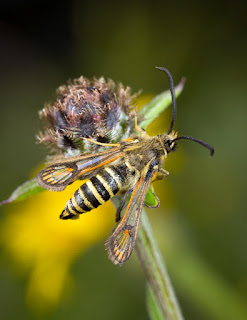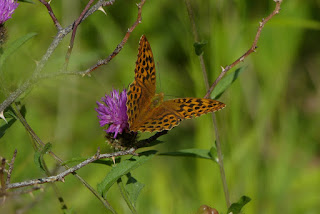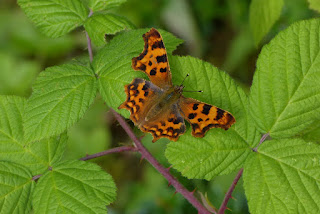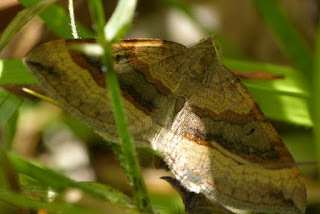Arriving for our second visit to this site this year we were met by two moth trappers. They had trapped the night before and had just finished going through the catch. Thus, the first 10-15 minutes was taken up by looking at what they had found.
Inspection over we got ready and eventually we left the car parking area. On our last visit we took a circular route around the site in a clockwise direction. So, this time, for a change we started out on a similar route but anti-clockwise. You cannot say we are not adventurous.
We walked about 40 yards into the first meadow then set up camp there staying for about the next 45 minutes. We set a fast pace.
 |
| Photograph: David Williams |
 |
| Photograph: Jim Cresswell |
 |
| Photograph: Jim Cresswell |
And on some water in the vicinity a pondskater provided a wonderful subject on which to practice photographic skills.
 |
| Photograph: David Williams |
Pretty impressive - and no need for Photoshop.
Having scoured the field and its surrounding vegetation I realised that if we did not move on
1) We could be having lunch within 40 yards of the cars;
2) We would never get around the site.
We moved into the next meadow which was smaller, wetter and with a good variety of vegetation of different heights.
A male red-tailed bumble bee was feeding on an umbellifer head
 |
| Photograph: Jim Cresswell |
Knapweed in this area was proving particularly attractive to the tachinid fly Prosena siberita.
 |
| Photograph: David Williams |
These reports rarely include any photographs of flies other than hoverflies and craneflies so I am pleased to be able to include this one and a few others that will follow. Flies are all around us and, although sometimes unwelcome such as horseflies and mosquitoes, make up a major part of the fauna and should be enjoyed.
A couple of other finds to report, then .... guess what?
A comma proudly displaying its comma marking on the underside of the hind wing.
 |
| Photograph: Jim Cresswell |
And a harvestman Nemastoma bimaculatum.
 |
| Photograph: David Williams |
It's not hard.
Lunch
Satiated we moved on. We still had about 90% of the lap to go.
We entered an area of longer vegetation and woodland as the path bordered a stream. Of passing interest were the long-horn beetle Rutpela maculata.
This is a regular in these reports and is always a delight to see.
Another fly! And another tachinid - Macquartia praefica.
 |
| Photograph: Nigel Jones |
And a cuckoo bee - Bombus barbutellus
 |
| Photograph: David Williams |
The hymenopterists in the group got quite excited by this find, so I assume it is unusual to see it in these parts.
Cuckoo bees follow the example of the bird they are named after, that is, they take over the nests of other bumble bees. This cuckoo takes over the nest of the Garden bumble bee Bombus hotorum.
At this point I saw a plant that I thought was cowwheat, so the heavy gang were called in to look for the Cowwheat shieldbug
The shieldbug was not found.
Not surprising really, the plant was greater stitchwort!
A new member of the group wandered down the path.
It joined us as we ascended through the woodland to the next meadow then decided it had had enough and settled down to rest.
Emerging from the wood we entered a wonderfully flower rich meadow with glorious views of the hills
This area held our attention for most of the afternoon.
What about the rest you may ask?
Well, there is always another day.
Our dipterist was especially pleased about a fly that one of the group had found.
"A very interesting conopid" I think he said.
It was. It was a nationally scarce fly that had not been recorded in Shropshire for over 30 years - Thecophora fulvipes.
 |
| Photograph: Nigel Jones |
Small coppers were flitting about and one took a fancy to the picture of an Eyed hawkmoth on the front of an identification guide
 |
| Photograph: David Williams |
 |
| Photograph: David Williams |
It was, so we moved on swiftly through the next field, pausing only to look at a dead tree and a centipede.
 |
| Photograph: Jim Cresswell |
 |
| Photograph: David Williams |
One last fly. I am not sure where this was seen but the timing of the photograph is after the one above. This one is a robber fly - Machimus atricapillus.
How could we refuse?
So we didn't.
As we enjoyed our drink our orthopterist investigated the compost heap to look for little earwigs which ply their trade in this environment. He was not successful, but he found a pseudoscorpion which turned out to be the "Compost chernes".
My thanks to Mags Cousins for inviting us to the site, to the photographers David Williams, Jim Cresswell and Nigel Jones for generously allowing me to use the results of their craft and to the group for once again providing excellent company as well as spotting lots of interesting wee beasties.
What has the title of this piece got to do with the rest you may wonder?
If you have seen the film "Fargo" and its spin-off TV series you will know it starts "This is a true story" "The events happened in Minnesota in ..." This is untrue, it is not a true story although it may be tenuously based on some event somewhere in the world.
Well this report is a true story based on events that happened at Bagbatch on Sunday 23rd August. The key word is "based". I am the grateful recipient of photographs from attendees but am not always aware of where and when they were taken on the trip so I try to put together a plausible tale from what I remember and the photographs.
I hope you enjoyed it!















































































